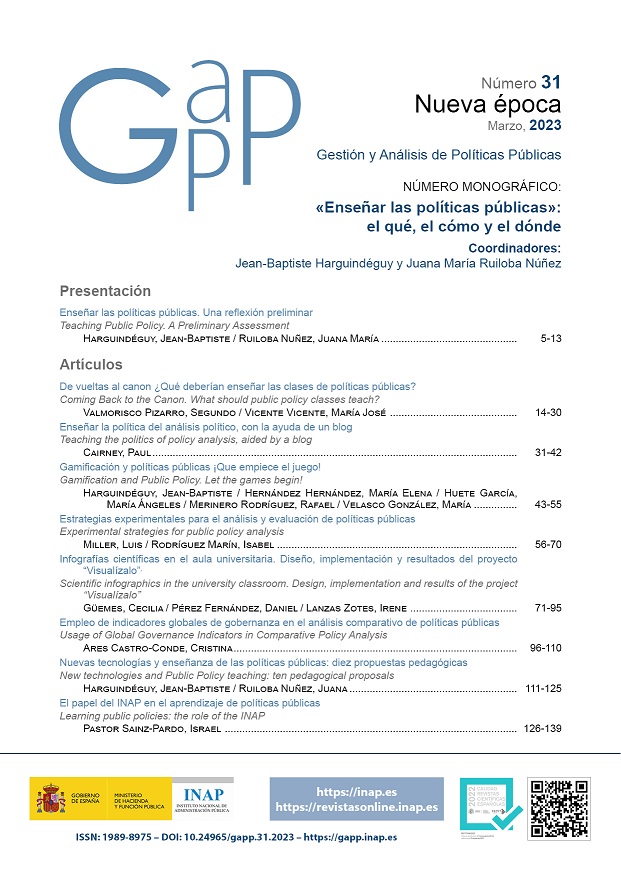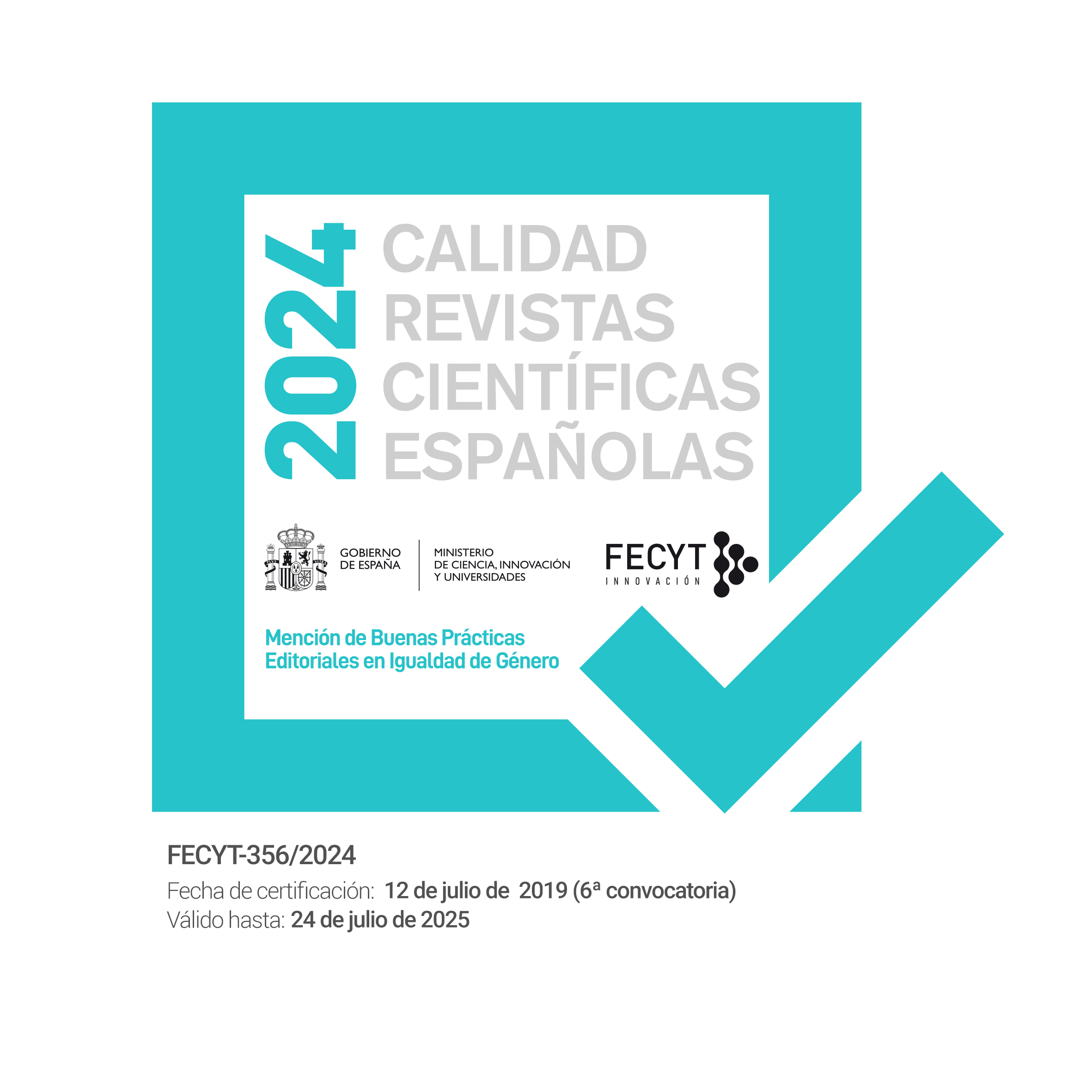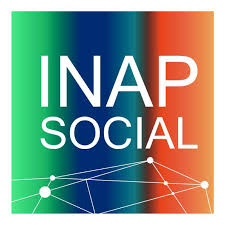Teaching the politics of policy analysis, aided by a blog
DOI:
https://doi.org/10.24965/gapp.11146Keywords:
Teaching, policy analysis, bounded rationality, blog, public administrationAbstract
When we teach policy analysis, we should focus not only on how to be a policy analyst but also how to situate the act of analysis within a wider political and policymaking context. There is the potential to achieve this aim: policy analysis texts focus on the individual and professional skills required to act efficiently and effectively in a time-pressured political environment, policy process research helps to situate this activity in a policymaking environment out of their control, and critical policy analysis prompts students to identify the inequalities of power that underpin policy practice and outcomes. However, students embody the concept of “bounded rationality” that is central to such studies: there is an overwhelming amount of information that they could encounter, and they have limited resources to learn. In that context, how can we help students to navigate the study of public policy well enough to make “good enough” choices about what and how to learn? I discuss the role of blog posts (and textbook materials) to foster that learning, and a mixture of coursework to help students reflect on the practical implications of what they learn.
Downloads
References
Bacchi, C. (2009). Analysing Policy: What’s the problem represented to be? (1.ª ed.). Pearson Education.
Bardach, E., & Patashnik, E. (2020). A Practical Guide for Policy Analysis (6.ª ed.) [international student edition]. SAGE.
Baumgartner, F., & Jones, B. (2009). Agendas & Instability in American Politics (2.ª ed.). University of Chicago Press.
Baumgartner, F., & Jones, B. (2015). The Politics of Information. Problem Definition & the Course of Public Policy in America. University of Chicago Press.
Brans, M., Geva-May, I., & Howlett, M. (2017). The policy analysis movement: The state of the art. In M. Brans, I. Geva-May y M. Howlett (eds.), Routledge Handbook of Comparative Policy Analysis. Routledge.
Cairney, P. (2016). The Politics of Evidence-Based Policy Making (1.ª ed.). Palgrave Pivot.
Cairney, P. (2020). Understanding Public Policy: Theories and Issues (2.ª ed.). Red Globe.
Cairney, P. (2021a). The Politics of Policy Analysis. Palgrave Macmillan.
Cairney, P. (2021b). The politics of policy design. EURO Journal on Decision Processes, 9, article 100002, 1-8. https://doi.org/10.1016/j.ejdp.2021.100002
Cairney, P., & Kwiatkowski, R. (2017). How to Communicate Effectively with Policymakers: Combine Insights from Psychology and Policy Studies. Palgrave Communications, 3, article 37. https://www.nature.com/articles/s41599-017-0046-8
Cairney, P., & Weible, C. (2017). The new policy sciences: combining the cognitive science of choice, multiple theories of context, and basic and applied analysis. Policy Sciences, 50(4), 619-627. https://doi.org/10.1007/s11077-017-9304-2
Cairney, P., Heikkila, T., & Wood, M. (2019). Making Policy in a Complex World [serie: Elements in Public Policy]. Cambridge University Press.
Cairney, P., Keating, M., Kippin, S., & St Denny, E. (2022). Public Policy to Reduce Inequalities Across Europe: hope versus reality. Oxford University Press.
Crow, D., & Jones, M. (2018). Narratives as Tools for Influencing Policy Change. Policy & Politics, 46(2), 217-234. https://doi.org/10.1332/030557318X15230061022899
Doucet, F. (2019). Centering the Margins: (Re)defining Useful Research Evidence Through Critical Perspectives. William T. Grant Foundation. https://eric.ed.gov/?id=ED609713
Dunn, W. (2017). Public Policy Analysis: An Integrated Approach (6.ª ed.). Routledge.
Durnová, A., & Weible, C. (2020). Tempest in a teapot? Toward new collaborations between mainstream policy process studies and interpretive policy studies. Policy Sciences, 53, 571-588. https://doi.org/10.1007/s11077-020-09387-y
Enserink, B., Koppenjan, J., & Mayer, I. (2013). A Policy Sciences View on Policy Analysis. In W. Thissen & W. Walker (eds.), Public Policy Analysis: New Developments (pp. 11-40). Springer.
Fischer, F. (1998). Beyond empiricism: policy inquiry in postpositivist perspective. Policy Studies Journal, 26(1), 129-146. https://doi.org/10.1111/j.1541-0072.1998.tb01929.x
Fukuyama, F. (2018, august 1). What’s Wrong with Public Policy Education. The American Interest (accessed 12.2.20). https://www.the-american-interest.com/2018/08/01/whats-wrong-with-public-policy-education/
Geva-May, I. (ed.) (2005). Thinking Like a Policy Analyst Policy: Analysis as a Clinical Profession. Palgrave Macmillan.
Gigerenzer, G. (2001). The Adaptive Toolbox. In G. Gigerenzer & R. Selten (eds.), Bounded rationality: The adaptive toolbox (pp. 37-50). The MIT Press.
Hassenteufel, P., & Zittoun, P. (2017). From Policy Analytical Styles to Policymaking Styles. In M. Brans, I. Geva-May, & M. Howlett (eds.), Routledge Handbook of Comparative Policy Analysis (pp. 56-69). Routledge.
Hindess, B. (1977). Philosophy and Methodology in the Social Sciences. Harvester Press.
Hogwood, B., & Gunn, L. (1984). Policy Analysis for the Real World. Oxford University Press.
Jones, M., & Radaelli, C. (2016). The narrative policy framework’s call for interpretivists. Critical Policy Studies, 10(1), 117-120. https://doi.org/10.1080/19460171.2015.1111156
Jones, M., Shanahan, E., & McBeth, M. (eds.) (2014). The Science of Stories: Applications of the Narrative Policy Framework in Public Policy Analysis. Palgrave Macmillan.
Jordan, A. G., & Cairney, P. (2013). What is the “Dominant Model” of British Policy Making? Comparing Majoritarian and Policy Community Ideas. British Politics, 8(3), 233-259. https://doi.org/10.1057/bp.2013.5
Jordan, A. G., & Maloney, W. A. (1997). Accounting for Subgovernments: Explaining the Persistence of Policy Communities. Administration and Society, 29(5), 557-583. https://doi.org/10.1177/009539979702900503
Kahneman, D. (2012). Thinking Fast and Slow. Penguin.
Kingdon, J. (1984). Agendas, Alternatives and Public Policies. Harper Collins.
Koski, C., & Workman, S. (2018). Drawing practical lessons from punctuated equilibrium theory. Policy and Politics, 46(2), 293-308. https://doi.org/10.1332/030557318X15230061413778
Lasswell, H. (1951). The policy orientation. In D. Lerner, & H. Lasswell (eds.), The policy sciences. Stanford University Press.
Lasswell, H. (1956). The political science of science: An Inquiry into the Possible Reconciliation of Mastery and Freedom. American Political Science Review, 50(4), 961-979. https://doi.org/10.2307/1951330
Lasswell, H. (1971). A pre-view of the policy sciences. American Elsevier Publishing.
Lindblom, C. (1959). The Science of Muddling Through. Public Administration Review, 19(2), 79-88. https://doi.org/10.2307/973677
Lindblom, C. (1979). Still Muddling, Not Yet Through. Public Administration Review, 39(6), 517-526. https://doi.org/10.2307/976178
Mayer, I., van Daalen, C. E., & Bots, P. (2013). Perspectives on Policy Analysis: A Framework for Understanding and Design. In W. Thissen, & W. Walker (eds.), Public Policy Analysis: New Developments (pp. 41-64). Springer.
Meltzer, R., & Schwartz, A. (2019). Policy Analysis as Problem Solving: A Flexible and Evidence-Based Framework. Routledge.
Mintrom, M. (2012). Contemporary Policy Analysis. Oxford University Press.
Mintrom, M. (2019). So you want to be a policy entrepreneur? Policy Design and Practice, 2(4), 307-323. https://doi.org/10.1080/25741292.2019.1675989
Ostrom, E. (2007). Institutional Rational Choice. In P. Sabatier (ed.), Theories of the Policy Process (2.ª ed.). Westview Press.
Ostrom, E. (2011). Background on the Institutional Analysis and Development Framework. Policy Studies Journal, 39(1), 7-27. https://doi.org/10.1111/j.1541-0072.2010.00394.x
Radin, B. (2019). Policy Analysis in the Twenty-First Century. Routledge.
Richardson, J. J., & Jordan, G. (1979). Governing under Pressure: The Policy Process in a Post-Parliamentary Democracy [Government and administration series]. Martin Robertson, & Company Ltd.
Sabatier, P., & Weible, C. (2007). The Advocacy Coalition Framework: Innovations and Clarifications. In P. Sabatier (ed.) Theories of the Policy Process. Westview Press.
Schlager, E., & Cox, M. (2018). The IAD Framework and the SES Framework: An Introduction and Assessment of the Ostrom Workshop Frameworks. In C. Weible, & P. Sabatier (eds.), Theories of the Policy Process (4.ª ed.). Routledge.
Schneider, A., & Ingram, H. (1997). Policy Design for Democracy. University Press of Kansas.
Schneider, A., & Ingram, H. (eds.) (2005). Deserving and Entitled: Social Construction and Public Policy. State University of New York Press.
Simon, H. (1976). Administrative Behavior: A study of decision-making processes in administrative organization (3.ª ed.). Free Press.
Smith, L. T. (2012). Decolonizing Methodologies: Research and Indigenous Peoples (2.ª ed.). Zed Books.
Stone, D. (2012). Policy Paradox: The Art of Political Decision Making (3.ª ed.). WW Norton, & Co.
Thissen, W., & Walker, W. (eds.) (2013). Public Policy Analysis: New Developments. Springer.
True, J., Jones, B., & Baumgartner, F. (2007). Punctuated Equilibrium Theory: explaining stability and change in public policymaking. In P. Sabatier (ed.), Theories of the Policy Process (2.ª ed.). Westview Press.
Weible, C., & Cairney, P. (2018). Practical lessons from policy theories. Policy and Politics, 46(2), 183-197. https://doi.org/10.1332/030557318X15230059147191
Weible, C., Heikkila, T., deLeon, P., & Sabatier, P. (2012). Understanding and influencing the policy process. Policy Sciences, 45(1), 1-21. https://doi.org/10.1007/s11077-011-9143-5
Weimer, D., & Vining, A. (2017). Policy Analysis: Concepts and Practice (6.ª ed.). Routledge.
Downloads
Published
How to Cite
Issue
Section
License
Copyright (c) 2022 Gestión y Análisis de Políticas Públicas

This work is licensed under a Creative Commons Attribution-NonCommercial 4.0 International License.












